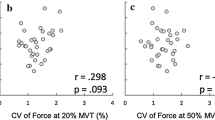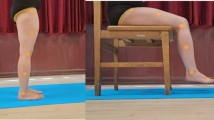Abstract
Considerable evidence shows that sensation from the feet and ankles is important for standing balance control. It remains unclear, however, to what extent specific foot and ankle sensory systems are involved. This study focused on the role of plantar cutaneous sensation in quasi-static balance control. Iontophoretic delivery of anesthesia was used to reduce the sensitivity of the forefoot soles. In a follow-up experiment, subjects received intradermal injections of local anesthetic into the entire weight-bearing surface of the foot soles. Properties of the center-of-foot-pressure (COP) trajectories and ground reaction shear forces were analyzed using stabilogram–diffusion analysis and summary statistics. Effects of foot-sole anesthesia were generally small and mostly manifested as increases in COP velocity. Magnitude of COP displacement was unaffected by foot-sole anesthesia. Forefoot anesthesia mainly influenced mediolateral posture control, whereas complete foot-sole anesthesia had an impact on anteroposterior control. During bipedal stance, statistically significant effects of foot-sole anesthesia on COP were present only under eyes-closed conditions and included increases in COP velocity (11–12%) and shear force root-mean-square (13%), the latter indicating increases in body center-of-mass accelerations due to the foot-sole anesthesia. Similar effects were seen for unipedal stance in addition to an increase in anteroposterior COP median frequency (36%). Changes in stabilogram–diffusion parameters were confined to the short-term region suggesting that sensory information from the foot soles is mainly used to set a relevant background muscle activity for a given posture and support surface characteristic, and consequently is of little importance for feedback control during unperturbed stance. In general, this study demonstrates that plantar sensation is of moderate importance for the maintenance of normal standing balance when the postural control system is challenged by unipedal stance or by closing of the eyes. The impact of reduced plantar sensitivity on postural control is expected to increase with the loss of additional sensory modalities such as the concomitant proprioceptive deficits commonly associated with peripheral neuropathies.


Similar content being viewed by others
Notes
Pressure sensory threshold levels have historically been expressed in arbitrary units (a.u.) that are considered a linear scale of perceived force and correspond approximately to a logarithmic scale of filament buckling force.
The subjects in procedure 2 also performed dynamic tests of balance that will be detailed in future publications. The unperturbed balance tests performed in procedure 2 were confined to a subset of those used in procedure 1 so that sufficient anesthesia could be maintained for both quasi-static and dynamic testing.
Statistically significant increases in COP velocity after whole-sole anesthesia were seen only in the planar dimension. A notable increasing trend (p=0.066) in anteroposterior COP velocity suggests that the increase in planar COP velocity may be primarily due to increases in AP COP velocity.
References
Apfel SC (1999) Diabetic polyneuropathy CME. In: Diabetes and endocrinology clinical management, vol 1999. Medscape Inc., pp 1–30
Asai H, Fujiwara K, Toyoma H, Yamashina T, Nara I, Tachino K (1990) The influence of foot soles cooling on standing postural control. In: Brandt TH, Paulus W, Bles W, Deitrich M, Krafezyk S, Straube A (eds) Disorders of Posture and Gait. Thieme, Stuttgart, pp 198–201
Bloem BR, Allum JH, Carpenter MG, Honegger F (2000) Is lower leg proprioception essential for triggering human automatic postural responses? Exp Brain Res 130:375–391
Boucher P, Teasdale N, Courtemanche R, Bard C, Fleury M (1995) Postural stability in diabetic polyneuropathy. Diabetes Care 18:638–645
Carpenter MG, Frank JS, Silcher CP, Peysar GW (2001) The influence of postural threat on the control of upright stance. Exp Brain Res 138:210–218
Cavanagh PR, Simoneau GG, Ulbrecht JS (1993) Ulceration, unsteadiness, and uncertainty—the biomechanical consequences of diabetes-mellitus. J Biomech 26:23–40
Cherepakhin MA, Purakhin YN, Petukhov BN (1973) Human sensorimotor coordination following space flights. In: Livingston RB (ed) Life sciences and space research, vol 11. Akademie-Verlag, Berlin, pp 117–121
Chow CC, Collins JJ (1995) Pinned polymer model of posture control. Phys Rev E 52:907–912
Collins JJ, De Luca CJ (1993) Open-loop and closed-loop control of posture: a random-walk analysis of center-of-pressure trajectories. Exp Brain Res 95:308–318
Collins JJ, De Luca CJ (1995) The effects of visual input on open-loop and closed-loop postural control mechanisms. Exp Brain Res 103:151–163
Dollery C (1991) Therapeutic drugs. Churchill Livingstone, London
Dupui P, Montoya R, Costes-Salon MC, Severac A, Guell A (1992) Balance and gait analysis after 30 days −6 degrees bed rest: influence of lower-body negative-pressure sessions. Aviat Space Environ Med 63:1004–1010
Geurts AC, Mulder TW, Nienhuis B, Mars P, Rijken RA (1992) Postural organization in patients with hereditary motor and sensory neuropathy. Arch Phys Med Rehabil 73:569–572
Gutierrez EM, Helber MD, Dealva D, Ashton-Miller JA, Richardson JK (2001) Mild diabetic neuropathy affects ankle motor function. Clin Biomech (Bristol, Avon) 16:522–528
Hämäläinen H, Kekoni J, Rautio J, Matikainen E, Juntunen J (1992) Effect of unilateral sensory impairment of the sole of the foot on postural control in man—implications for the role of mechanoreception in postural control. Hum Mov Sci 11:549–561
Hayashi R, Miyake A, Watanabe S (1988) The functional role of sensory inputs from the foot: stabilizing human standing posture during voluntary and vibration-induced body sway. Neurosci Res 5:203–213
Holewski JJ, Stess RM, Graf PM, Grunfeld C (1988) Aesthesiometry: quantification of cutaneous pressure sensation in diabetic peripheral neuropathy. J Rehabil Res Dev 25:1-10
Horak FB, Nashner LM, Diener HC (1990) Postural strategies associated with somatosensory and vestibular loss. Exp Brain Res 82:167–177
Inglis JT, Horak FB, Shupert CL, Jones-Rycewicz C (1994) The importance of somatosensory information in triggering and scaling automatic postural responses in humans. Exp Brain Res 101:159–164
Kavounoudias A, Roll R, Roll JP (1999) Specific whole-body shifts induced by frequency-modulated vibrations of human planter soles. Neurosci Lett 266:181–184
Kavounoudias A, Roll R, Roll JP (2001) Foot sole and ankle muscle inputs contribute jointly to human erect posture regulation. J Physiol 532:869–878
Konradsen L, Ravn JB, Sorensen AI (1993) Proprioception at the ankle: the effect of anaesthetic blockade of ligament receptors. J Bone Joint Surg Br 75:433–436
Kozlovskaya IB, Kreidich YV, Rakhmanov AS (1981) Mechanisms of the effects of weightlessness on the motor system of man. Physiologist 24:S59–S64
Kozlovskaya I, Dmitrieva I, Grigorieva L, Kirenskaya A, Kreidich Y (1988) Gravitational mechanisms in the motor system. Studies in real and simulated weightlessness. In: Gurfinkel VS, Ioffe ME, Massion J, Roll JP (eds) Stance and motion: facts and concepts. Plenum Press, New York, pp 37–48
Magnusson M, Enbom H, Johansson R, Wiklund J (1990a) Significance of pressor input from the human feet in lateral postural control. The effect of hypothermia on galvanically induced body-sway. Acta Otolaryngol 110:321–327
Magnusson M, Enbom H, Johansson R, Pyykko I (1990b) Significance of pressor input from the human feet in anterior-posterior postural control. The effect of hypothermia on vibration-induced body-sway. Acta Otolaryngol (Stockh) 110:182–188
Maurer C, Mergner T, Bolha B, Hlavacka F (2001) Human balance control during cutaneous stimulation of the plantar soles. Neurosci Lett 302:45–48
Mauritz KH, Dietz V (1980) Characteristics of postural instability induced by ischemic blocking of leg afferents. Exp Brain Res 38:117–119
Meyer P (2003) The role of plantar cutaneous afferents in quasi-static and dynamic balance control. PhD Thesis. Biomedical Engineering, Boston University, Boston MA
Meyer PF, Oddsson LI (2003) Alternating-pulse iontophoresis for targeted cutaneous anesthesia. J Neurosci Methods 125:209–214
Morasso PG, Schieppati M (1999) Can muscle stiffness alone stabilize upright standing? J Neurophysiol 82:1622–1626
Morasso PG, Baratto L, Capra R, Spada G (1999) Internal models in the control of posture. Neural Netw 12:1173–1180
Nashner LM, Black FO, Wall C III (1982) Adaptation to altered support and visual conditions during stance: patients with vestibular deficits. J Neurosci 2:536–544
Perry SD, McIlroy WE, Maki BE (2000) The role of plantar cutaneous mechanoreceptors in the control of compensatory stepping reactions evoked by unpredictable, multi- directional perturbation. Brain Res 877:401–406
Peterka RJ (2000) Postural control model interpretation of stabilogram diffusion analysis. Biol Cybern 82:335–343
Prieto TE, Myklebust JB, Hoffmann RG, Lovett EG, Myklebust BM (1996) Measures of postural steadiness: differences between healthy young and elderly adults. IEEE Trans Biomed Eng 43:956–966
Pyykko I, Jantti P, Aalto H (1990) Postural control in elderly subjects. Age Ageing 19:215–221
Richardson JK, Ashton-Miller JA (1996) Peripheral neuropathy: an often-overlooked cause of falls in the elderly. Postgrad Med 99:161–172
Richardson JK, Hurvitz EA (1995) Peripheral neuropathy—a true risk factor for falls. J Gerontol A Biol Sci Med Sci 50:M211–M215
Richardson JK, Ching C, Hurvitz EA (1992) The relationship between electromyographically documented peripheral neuropathy and falls. J Am Geriatr Soc 40:1008–1012
Roy SH, Bailin MT, Stecker MM, De Luca CJ (1985) Modeling postural sway in man: experimental evidence for a random process model of quiet standing. In: Proceedings of 15th Annual Meeting of the Society for Neuroscience
Simmons RW, Richardson C, Pozos R (1997) Postural stability of diabetic patients with and without cutaneous sensory deficit in the foot. Diabetes Res Clin Pract 36:153–160
Simoneau GG, Ulbrecht JS, Derr JA, Becker MB, Cavanagh PR (1994) Postural instability in patients with diabetic sensory neuropathy. Diabetes Care 17:1411–1421
Simoneau GG, Derr JA, Ulbrecht JS, Becker MB, Cavanagh PR (1996) Diabetic sensory neuropathy effect on ankle joint movement perception. Arch Phys Med Rehabil 77:453–460
Sosenko JM, Kato M, Soto R, Bild DE (1990) Comparison of quantitative sensory-threshold measures for their association with foot ulceration in diabetic patients. Diabetes Care 13:1057–1061
Van den Bosch CG, Gilsing MG, Lee SG, Richardson JK, Ashton-Miller JA (1995) Peripheral neuropathy effect on ankle inversion and eversion detection thresholds. Arch Phys Med Rehabil 76:850–856
van Deursen RW, Sanchez MM, Ulbrecht JS, Cavanagh PR (1998) The role of muscle spindles in ankle movement perception in human subjects with diabetic neuropathy. Exp Brain Res 120:1–8
Vinik AI, Suwanwalaikorn S, Stansberry KB, Holland MT, McNitt PM, Colen LE (1995) Quantitative measurement of cutaneous perception in diabetic neuropathy. Muscle Nerve 18:574–584
Acknowledgements
This work was supported by the National Aeronautics and Space Administration (NASA) Graduate Student Researchers Program Grant NGT-50309 (Meyer). Additional support was provided by Research Retirement Foundation 2001-056 (Oddsson) and NASA NCC9–127 (De Luca). The authors would like to thank Dr. M.T. Bailin for performing the anesthesia procedures and Dr. C.A. Tucker for the loan of critical equipment. They would also like to thank Drs. M.T. Bailin and R.R. Anderson for many useful discussions.
Author information
Authors and Affiliations
Corresponding author
Rights and permissions
About this article
Cite this article
Meyer, P.F., Oddsson, L.I.E. & De Luca, C.J. The role of plantar cutaneous sensation in unperturbed stance. Exp Brain Res 156, 505–512 (2004). https://doi.org/10.1007/s00221-003-1804-y
Received:
Accepted:
Published:
Issue Date:
DOI: https://doi.org/10.1007/s00221-003-1804-y




